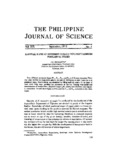Survival rates of different Penaeus monodon Fabricius postlarval stages
- Global styles
- MLA
- Vancouver
- Elsevier - Harvard
- APA
- Help

閲覧/開く
日付
1976Page views
3,576ASFA keyword
AGROVOC keyword
Taxonomic term
Metadata
アイテムの詳細レコードを表示する
Share
抄録
Four different postlarval stages (P11, P15 , P21, and P25) of P. monodon were stocked in suspension nets at the rate of 200 fry/sq m with 3 nets for each postlarval stage. Pond bottom was simulated by filling each net with a 15 cm layer of mud; dried twigs were provided for protection of the fry. Feeding with lablab and determination of temperature, dissolved oxygen, pH, salinity and alkalinity were regularly undertaken. Results show higher survival rates for P15 and P18 compared to the other stages.
Suggested Citation
Primavera, J. (1976). Survival rates of different Penaeus monodon Fabricius postlarval stages. Philippine Journal of Science , 105(3), 103-109. http://hdl.handle.net/10862/1068
Type
ArticleISSN
0031-7683Collections
- Journal Articles [1258]
Related items
Showing items related by title, author, creator and subject.
-
An overview of the nutrition, feed and feeding techniques of prawn penaeid/shrimps
Piedad-Pascual, Felicitas (Philippine Council for Aquatic and Marine Research and Development, 1989)This paper echoes what transpired during the first International Conference of Penaeid Prawns/Shrimps held in Iloilo City in December 4-7, 1984, particularly on the Nutrition nd Feed Development. Around 25 papers were ... -
Series: Aquaculture extension manual; No. 19
Prawn hatchery operations
Parado-Estepa, Fe D.; Quinitio, Emilia T. ; Borlongan, Emeterio L. (Aquaculture Department, Southeast Asian Fisheries Development Center, 1996-05)
The manual, an updated version of the 1984 SEAFDEC/AQD manual, presents the underlying principles and step-by-step instructions of prawn larval and post-larval rearing. The techniques described are not only applicable to ...
; Borlongan, Emeterio L. (Aquaculture Department, Southeast Asian Fisheries Development Center, 1996-05)
The manual, an updated version of the 1984 SEAFDEC/AQD manual, presents the underlying principles and step-by-step instructions of prawn larval and post-larval rearing. The techniques described are not only applicable to ... -
The lowdown on world shrimp culture - II
Yap, Wilfredo G. (INFOFISH, 2001)This paper introduces some new members of the international shrimp culture club and goes on to discuss some recent technological innovations in the industry, particularly the polyculture of tilapia (mainly Oreochromis ...





